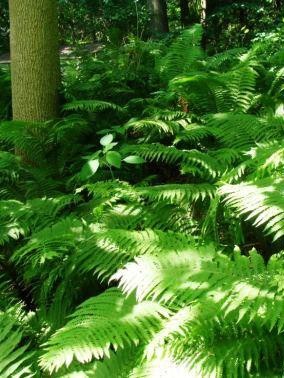Native Plants Sustain Wildlife

Matteuccia struthiopteris, Ostrich Fern
Explore and experience this rustic woodland garden of diverse native plants that preserves biodiversity by providing a habitat for wildlife. Native plants are hardy, adaptable, more disease-resistant, and require less care than non-natives.
Pause to consider the many species of animals that find food and shelter in this woodland habitat of native plants. Consider adding native plants to your yard to support wildlife.
Growing Conditions
The Hillside Garden is a woodland ecosystem with numerous vertical layers including large canopy trees, smaller understory trees and shrubs, vines, herbaceous plants, ferns, and ground covers. The crowns of the canopy trees capture the sunlight. When the trees are dormant and leafless, sun penetrates to the lower vertical levels. However, for most of the growing season, the understory and lower vertical layers are in partial to dense shade. The native plants thrive on the garden's steep slope with very little sun or moisture. Leaves from the trees serve as mulch and amend the soil with organic matter.
Description
To fully appreciate the garden, visitors should carefully observe each vertical layer of the landscape. The tall, strong Northern red oaks dominate the top canopy layer capturing the direct sunlight. The understory layer contains smaller trees in filtered lower light. These trees include black locust, flowering dogwood, sassafras, black cherry, serviceberry, and Eastern redbud.
Visitors can peer amongst the diverse shrubs in the lower understory layer and observe the different types of foliage, seeds, berries, and other fruits. In the dense shade on the floor of this woodland garden, visitors can discover a wide variety of wildflowers depending on the season.
This woodland habitat provides cover for wildlife and nests for birds, squirrels, and other mammals. In addition, this habitat provides nourishment for beneficial insects, birds, squirrels, chipmunks, groundhogs, raccoons, deer, and other mammals. Visitors frequently look around to see how many different birds, bees, caterpillars, butterflies, and mammals they can identify as they explore.
Background
This woodland setting was disrupted by construction many years ago, which destroyed many native plants and made it vulnerable to the introduction of unsightly invasive plants that did not support native wildlife. In 2002/2003, Master Gardeners and the Boy Scouts worked together to clear the land of invasive plants and to amend the disrupted soil with mulch. Since that time, the Master Gardeners have replaced many native plants that had been destroyed and added numerous other native plants that are well suited to this steep, shady environment.
Featured Plants*
Ferns
- Adianthum pedatum, Maidenhair fern
- Matteuccia struthiopteris, Ostrich fern
- Polystichum acrostichoides, Christmas fern
Herbaceous Plants
- Actaea pachypoda, White baneberry
- Aquilegia canadensis, Wild columbine
- Arisaema triphyllum, Jack-in-the-pulpit
- Aster divaricatus, White wood aster
- Chrysopsis villosa, Golden aster
- Dicentra canadensis, Native bleeding heart
- Echinacea paradoxa, Yellow coneflower
- Geranium maculatum 'Expresso', Wild geranium
- Heuchera americana, Coral bells
- Iris cristata, Crested iris
- Lobelia siphilitica, Blue lobelia
- Phlox Carolina, Thick-leaf phlox
- Phlox divaricata 'London Grove', Wild blue phlox
- Phlox divaricata 'Manita', Woodland phlox
- Phlox divaricata 'Mary Helen', Woodland phlox
- Phlox paniculata 'David', Fall phlox
- Phlox stolonifera, Creeping phlox
- Polemonium reptans 'Blue pearl', Jacob's ladder
- Rudbeckia fulgida, Orange coneflower
- Solidago spp. Goldenrod
- Stylophorum diphyllum, Celandine poppy
- Tradescantia virginiana, Spiderwort
- Aesculus parviflora, Bottlebrush buckeye
Shrubs
- Aronia arbutifolia, Red chokeberry
- Calycanthus floridus, Sweetshrub
- Cephalanthus occidentalis, Buttonbush
- Cornus sericea, Red twig dogwood
- Fothergilla gardenii, Dwarf fothergilla
- Hydrangea arborescens 'Annabelle', Wild hydrangea
- Ilex verticillata, Winterberry holly
- Itea virginica, Virginia sweetspire
- Lindera benzoin, Spicebush
- Myrica pensylvanica, Northern bayberry
- Rhododendron cumberlandense, Cumberland rhododendron
- Symphoricarpos albus, White coral berry
- Viburnum dentatum, Arrowwood
Trees
- Amelanchier canadensis, Serviceberry
- Cercis canadensis, Eastern redbud
- Chionanthus virginicus, Fringetree
- Cornus florida, Flowering dogwood
- Hamamelis virginiana, Common witchhazel
- Liriodendron tulipifera, Tulip poplar
- Prunus serotina, Black cherry
- Ptelea trifoliata, Wafer ash
- Quercus rubra, Northern red oak
- Robinia pseudoacacia, Black locust
- Sassafras albidum, Sassafras
- Tsuga canadensis, Canadian hemlock
*This is not a comprehensive plant list. The garden is dynamic in nature and plants may vary from year to year.

